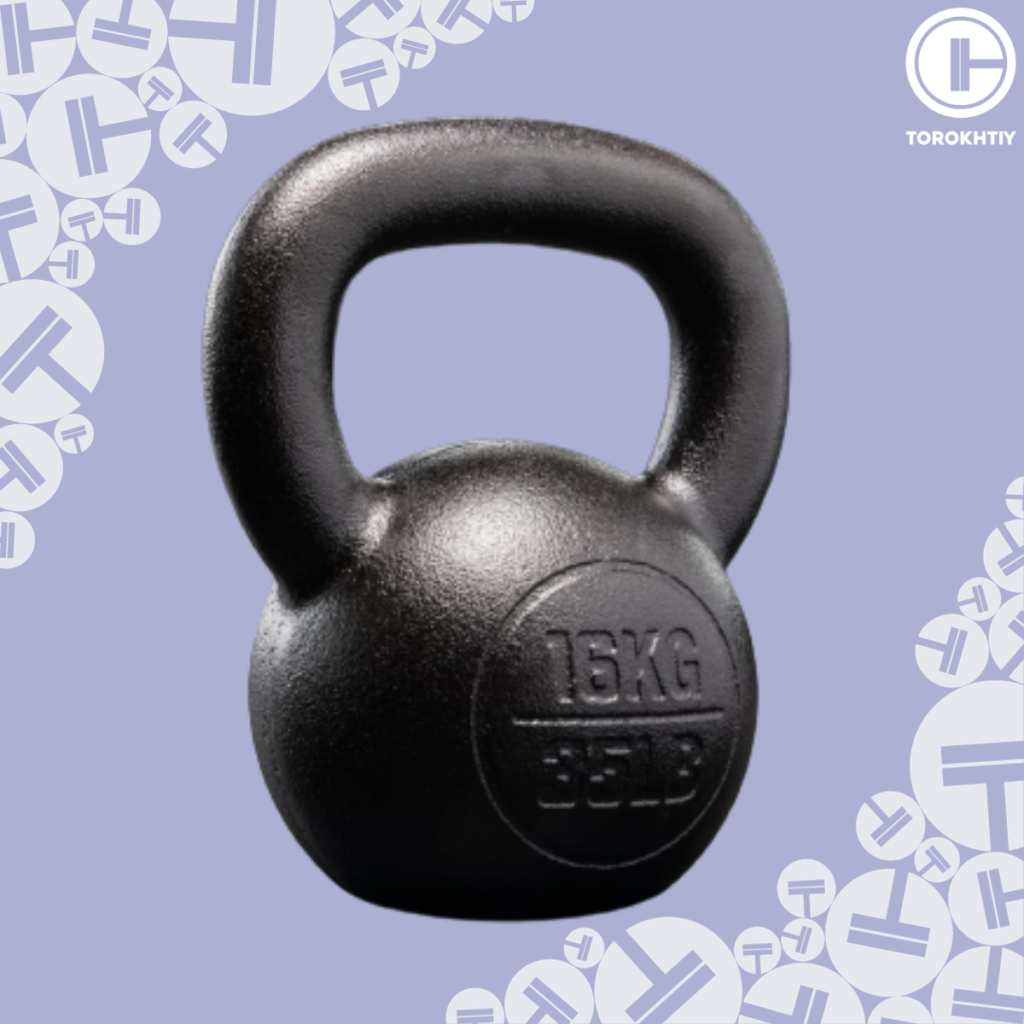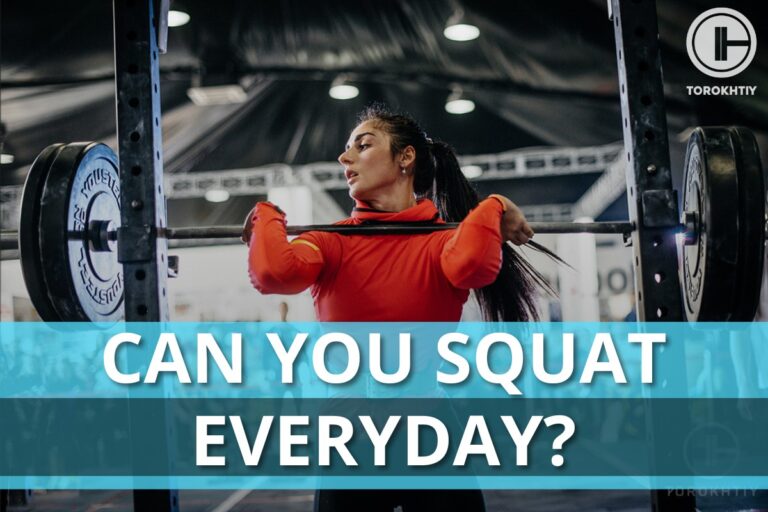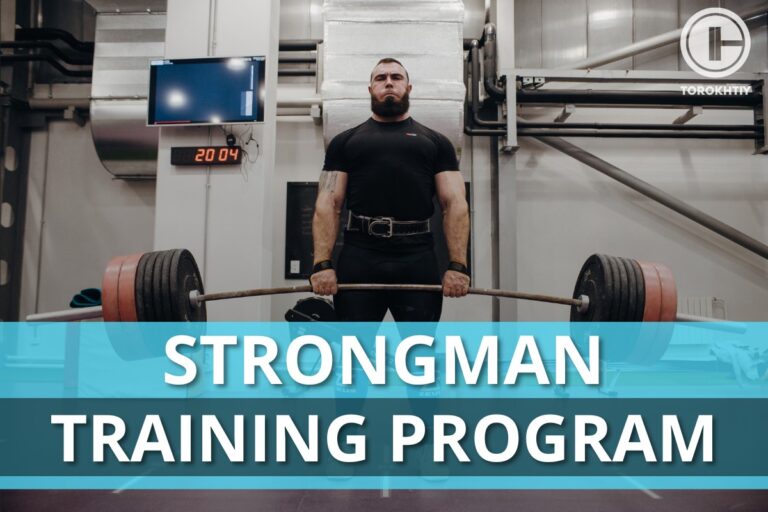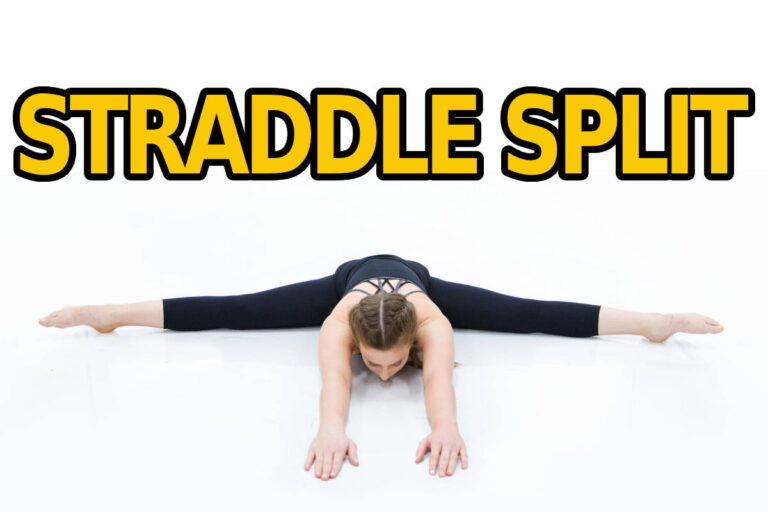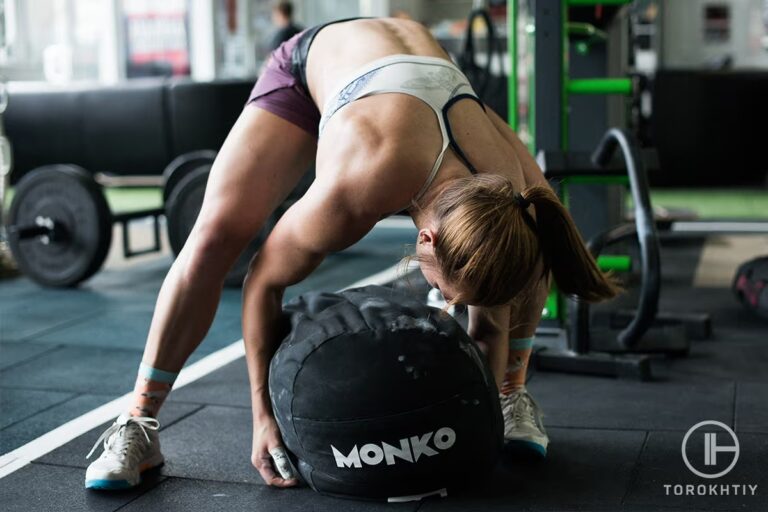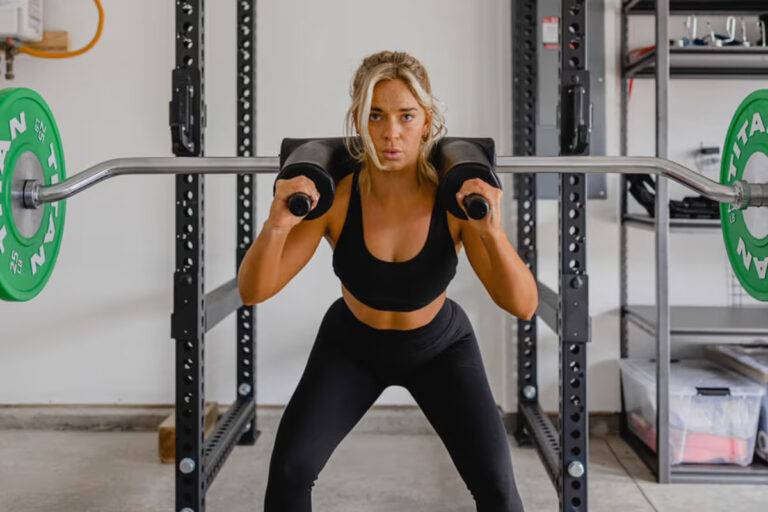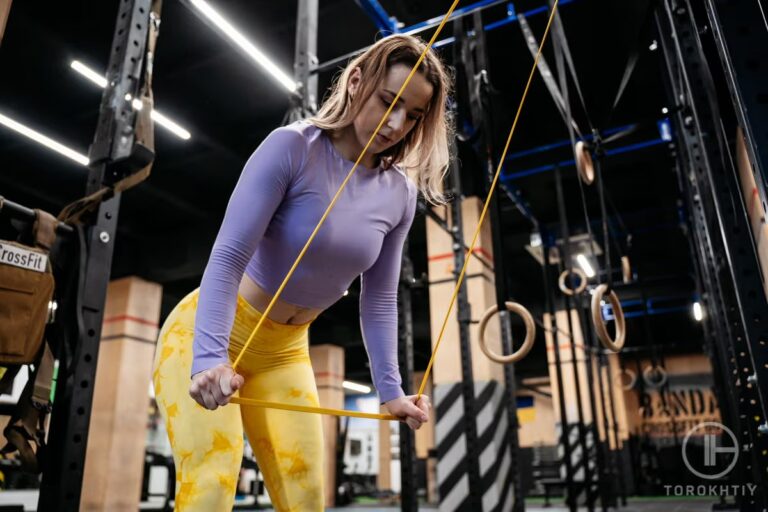10 Best Kettlebell Leg Exercises (With Workout Examples)
Some people look forward to leg day, some dread it and can’t wait until it’s over. Whichever group you belong to, the kettlebell leg workout can help you take your workout to the next level.
If you find leg days boring, you’ll be pleasantly shocked when you find out how including a kettlebell in your workout routine can spice things up and make it more interesting.
If, on the other hand, you look forward to leg day – the kettlebell is going to be a great addition to an already fun routine.
We’ll go into depth on how to achieve stronger, toned legs with kettlebell leg exercises; there’s going to be something for everyone, regardless of their fitness level. The dynamic exercises we’ll cover engage your entire lower-body and add an element of coordination and balance to your workouts, which makes them even more challenging.
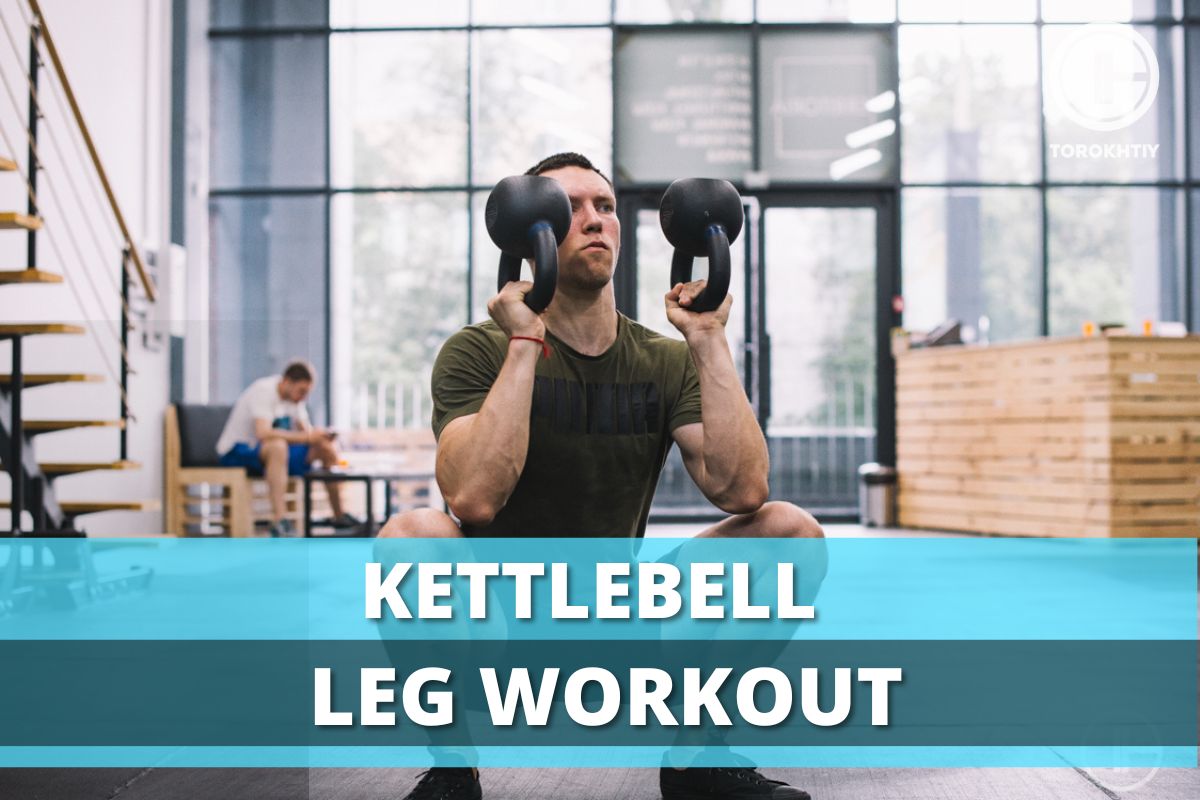
But enough rambling, let’s get into the good stuff!
What is a kettlebell leg workout? It’s an exercise that incorporates kettlebells to strengthen and tone lower body muscles. It usually involves dynamic movements like squats, lunges, and swings.
Is Kettlebell Workout Good For Your Legs? 9 Benefits
Lower-body kettlebell exercises are fantastic for your entire body. They’re an all-around approach to lower body fitness, they can be used in rehabilitation, and overall, they have a range of benefits that go beyond just looking good.
1. Stronger Legs
When you include a kettlebell in workouts like lunges or squats, you challenge your leg muscles much more because of the added resistance. That leads to your hamstrings, quads, and calves getting stronger. Not only does this make your legs look fantastic, but it also improves your overall athletic performance.
2. Muscle Toning
Kettlebell workouts will engage several muscle groups at the same time; this promotes balanced muscle development and a toned appearance.
3. More Endurance
Leg workouts that incorporate kettlebells can increase the endurance of your muscles. That means that you’ll be able to perform intense physical activities for longer periods of time.
4. Core Stability
You’ll notice that most of kettlebell leg workouts need core engagement for stability; this translates to a stronger core, muscle mass improvement, and better posture.
5. Increased Bone Density
Weight-bearing exercises like kettlebell workouts stimulate bone growth and density. This reduces the risk of osteoporosis and fractures but is also good for treating osteoporosis.
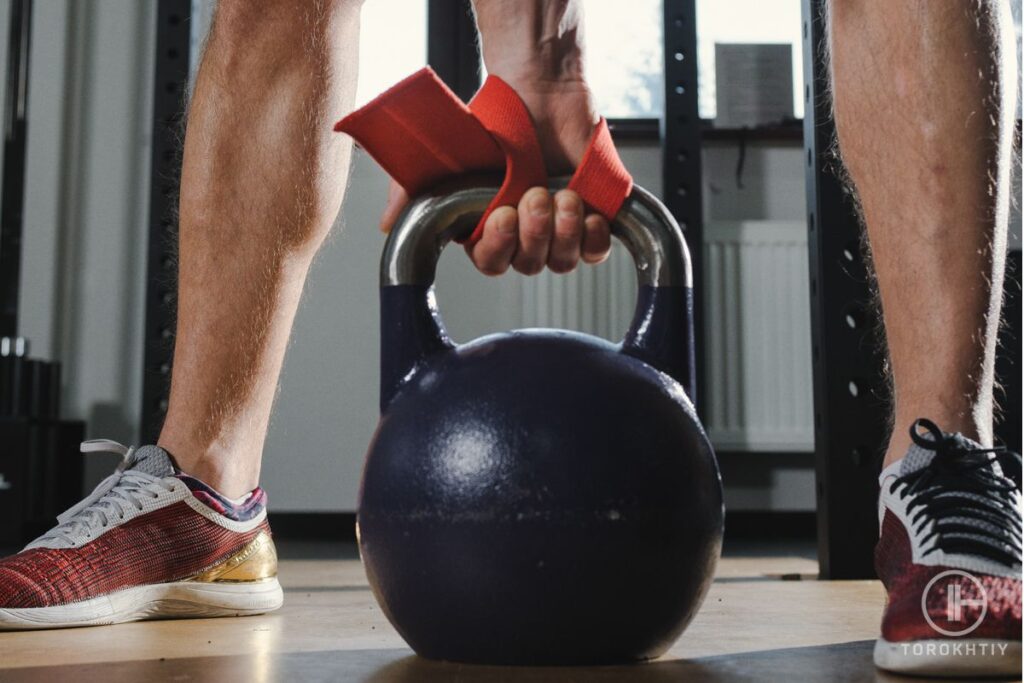
6. Functional Fitness
One of the best things about these workouts is that they mimic real-life movements. This makes your legs better prepared for everyday tasks. Think about moving heavy pieces of furniture or carrying big grocery bags – that’s where you really see the benefits of functional fitness.
7. Calorie Burn
As soon as you start doing one of these workouts, your heart rate will go up. The exercises are very dynamic and elevate your heart rate, which helps burn calories and can also help with fat loss. On average, working out with kettlebells allows you to burn about 20 calories per minute.
8. Joint Health
Kettlebell exercises require controlled, precise movements, which (when done correctly) promote joint stability and reduce the risk of injuries. Especially in the knees and hips.
9. Better Cardiovascular Health
Intense workouts help with cardiovascular health, so if you kick the kettlebell leg workouts up a notch, they can do wonders for your health.
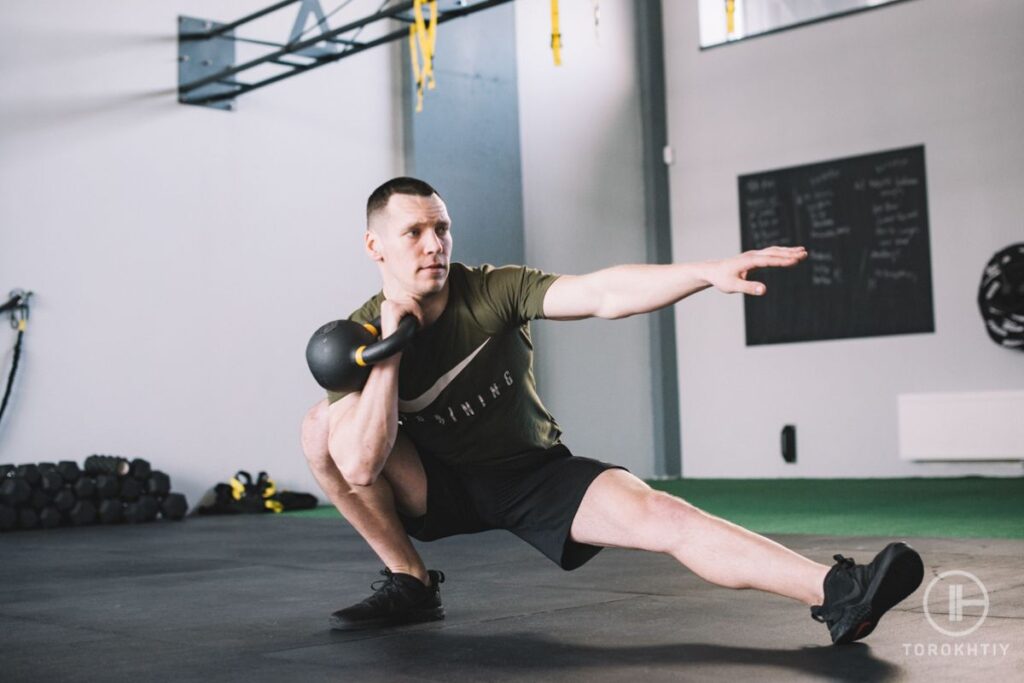
10 Best Kettlebell Leg Exercises
Kettlebells are absolutely fantastic for sculpting your lower body. It doesn’t matter if you want to target your hamstrings, quads, glutes, or just the entire lower region – there’s a workout that’s perfect for you.
Best Kettlebell Exercises for Quads
Goblet squats are high on the list of the best kettlebell quad exercises. They’re great for overall body strength, but the best thing about them is that they engage your core and promote better posture.
Hold a kettlebell close to your chest and stand with your feet shoulder-width apart. Lower into a squat while keeping your back and chest up. Then, push through your entire foot and go back up to where you started.
Front lunges are another good workout, and they’re ideal for building quad strength and endurance.
Hold a kettlebell with both hands at chest height and step forward with one leg. Lower into a lunge, allowing the front of your knee to move past the toes while maintaining solid posture. Push off the front foot and return to the starting position. Not only will this target your quads, but it will also improve your balance and coordination.
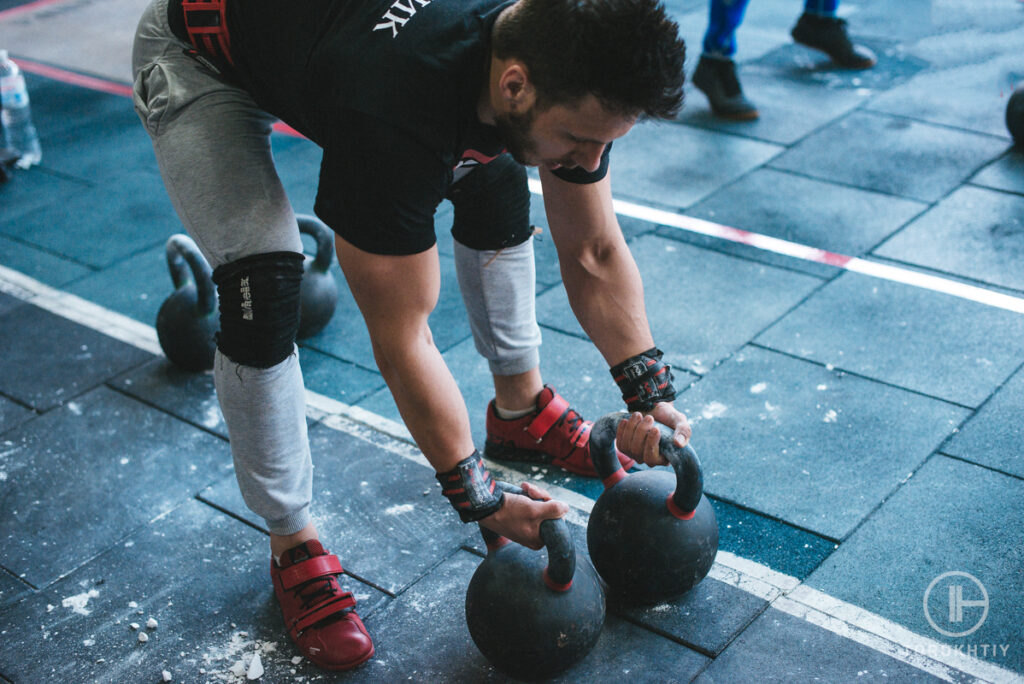
Best Kettlebell Exercises for Glutes
Kettlebell swings are fabulous at targeting your glutes and making them stronger. They also improve cardiovascular fitness and explosive power.
Stand with your feet hip-width apart and hold the kettlebell in front of you with both hands. Hinge at your hips and swing the kettlebell between your legs, then thrust your hips forward to swing it up to chest level. That’s an easy, basic workout, but you’ll be surprised at how fun and effective it is.
To further shape and tone your glutes, you can also do kettlebell sumo deadlifts. These will also improve hip mobility.
Place a kettlebell between your feet and point your toes slightly outward. Bend at the hips and knees to lower your body (your back needs to be straight!). Grab the kettlebell handle with both hands and stand up.
Best Kettlebell Exercises for Full Leg
Goblet squats are a potent way of enhancing your lower-body strength and mobility; with special emphasis on the full leg (quads, hamstrings, glutes, calves).
Hold a kettlebell with both hands close to your chest. Keep your feet at shoulder-width and proceed to do a squat. Start with a small hip hinge, bend your knees and descend as deep as comfortably possible while keeping the kettlebell at your chest the whole time. Your spine should be neutral/straight, and your ribcage should be neutral during the whole motion. When down, push through your entire foot to return to the starting position. Rinse and repeat!
Kettlebell step-ups are another workout that will improve your balance and make your legs stronger.
Hold a kettlebell in one hand by your side. Stand in front of a bench (or any other kind of sturdy surface) and step one foot onto the bench. Push through your whole foot and extend your leg fully. Lower yourself back down and repeat on the same leg. When you’re done, switch to the other.
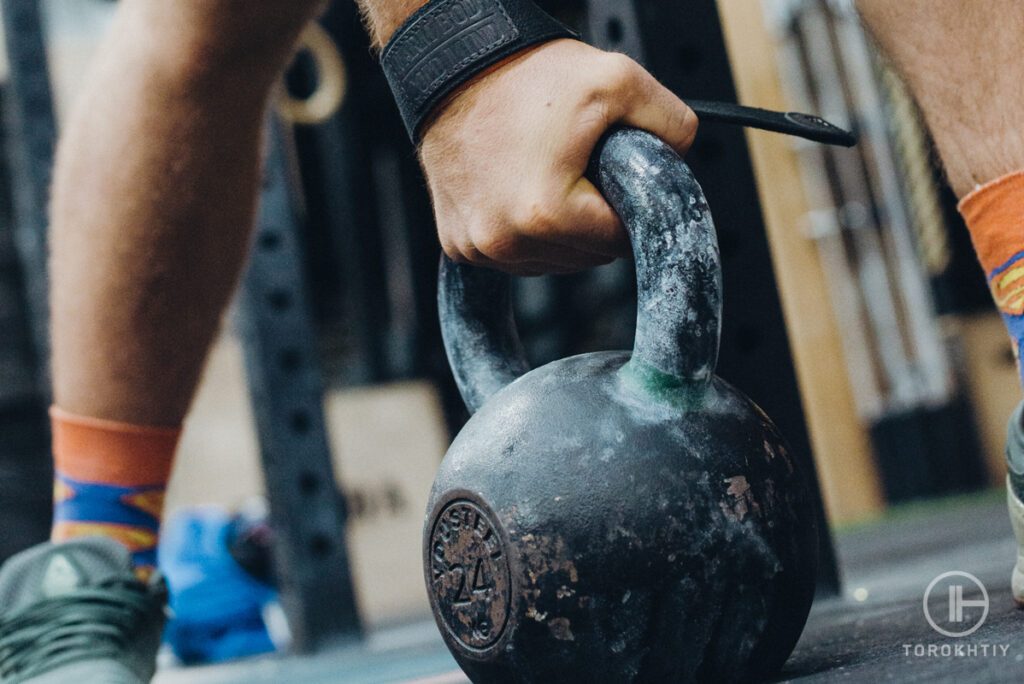
Best Kettlebell Exercises for Quads
Bulgarian split squats will burn your quads, engage hamstrings, and glutes and give you a comprehensive leg workout. They will also improve balance and stability.
Face away from the bench (or an elevated surface) with one foot resting on it. Lower into a lunge. In order to target your quadriceps, your front knee should be positioned further than your ankle (you’ll achieve this by bending deeper into the lunge). Push off the whole front foot and go back to the starting position. Try to go up and down without that “sawing” motion.
Best Kettlebell Exercises for Hamstrings
Moving on to kettlebell hamstring exercises! To target your hamstrings and lower back, do some kettlebell Romanian deadlifts. They will make your hamstrings stronger, more flexible, and stable.
Hold the kettlebell with both hands in front of your thighs. Start the motion by slightly hinging at your hip joint. After that small hip hinge, bend a little at the knees (ensure your shins remain vertical). Then, hinge at your hips (make sure your back is straight!) and lower the kettlebell towards the floor. Keep it close to your legs, then go back to where you started.
Single-leg deadlifts will isolate and strengthen the hamstrings and also improve your balance and stability. They’re some of the best single-leg kettlebell exercises you’ll ever do.
To do this, hold a kettlebell in one hand and balance on your leg. Keep your back straight and hinge at your hips to lower the kettlebell towards the floor while you extend your free leg behind you. Then, go back to the starting position. This is another very basic workout, but you’ll see it’s far more challenging than it looks.
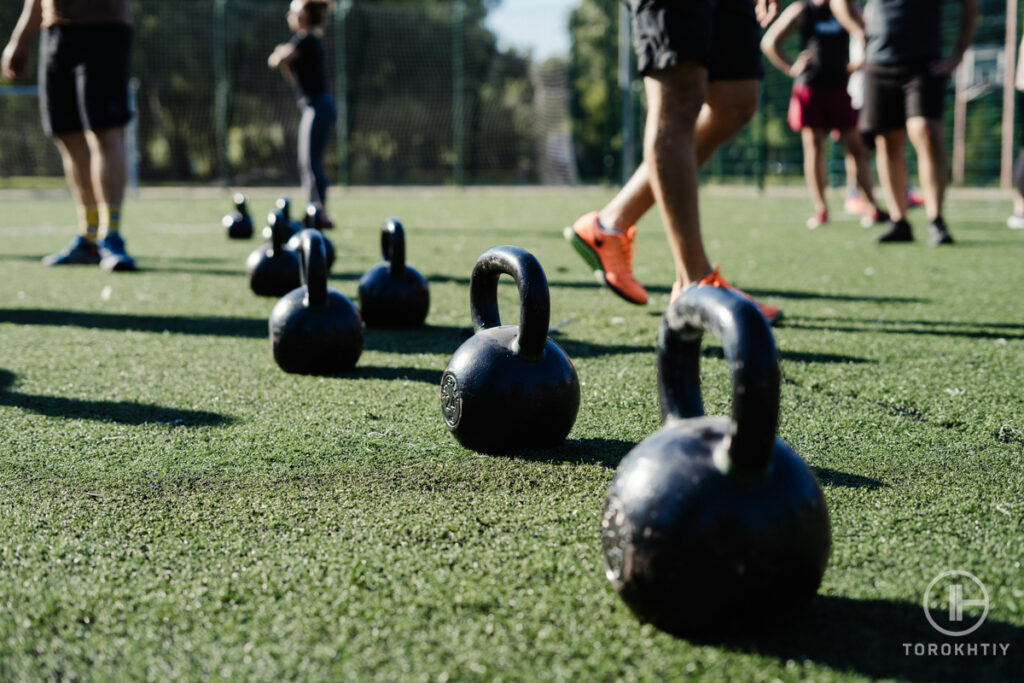
Best Kettlebell Exercises for Calves
There are two excellent workouts you can do for your calves – standing calf raises and seated calf raises. Both build strength and size in the calf muscles and will contribute to better balance and stability.
For standing calf raises, stand with your feet hip-width apart on an elevated surface (this can be a calf raise machine or just a step). Hold a kettlebell in one hand and place it on your shoulder to add some resistance. Raise your heels as high as you can by pushing through the balls of your feet, and then lower them below the level of your chosen surface. Get a good stretch, and then repeat.
Seated calf raises will target deeper calf muscles. Sit on a bench or a chair, bend your knees at 90 degrees, and keep your feet flat on the floor. Hold a kettlebell on your thighs or against your knees, and push through the balls of your feet to raise your heels as high as possible (your toes need to be on the floor the entire time). Lower your heels and repeat.
3 Levels of Kettlebell Leg Workout
All of these kettlebell exercises for legs are fantastic, but they won’t work for everyone because, depending on your fitness level, you need to make some adjustments; these could include the weight of the kettlebell, the duration of rest periods and the number of sets and reps.
So, the first thing you need to do is to determine what your level of fitness is. Then, you can move on to the workout routine.
1. Beginner
You’ll start your workout with 5-10 minutes of light cardio or dynamic stretches to warm up your muscles and prepare them for the workout. Do some jumping jacks, leg swings, and bodyweight squats.
Then, move on to goblet squats – 3 sets of 12 to 15 reps. Make sure to use a light kettlebell (18 – 26 lbs.) and make form a priority; keep your chest up and back straight. Don’t forget to rest for 30 seconds between sets!
Once you’re done with goblet squats, move on to kettlebell swings. Do 3 sets of 12 to 15 reps, with 30-second rest periods between sets. Again, you’ll need a light kettlebell and focus on hip thrusts and hinge movement.
Reverse lunges are next on the schedule: 3 sets of 10 reps on each leg. For these, you need to hold a light kettlebell in each hand at your sides, then step back into a lunge and return to your starting position.
When you finish with reverse lunges, finish your workout with 4 sets of 12 reps of glute bridges. Lie on your back with a kettlebell on your hips and lift your hips towards the ceiling.
Do 5-10 minutes of static stretching afterward, and your workout is done!
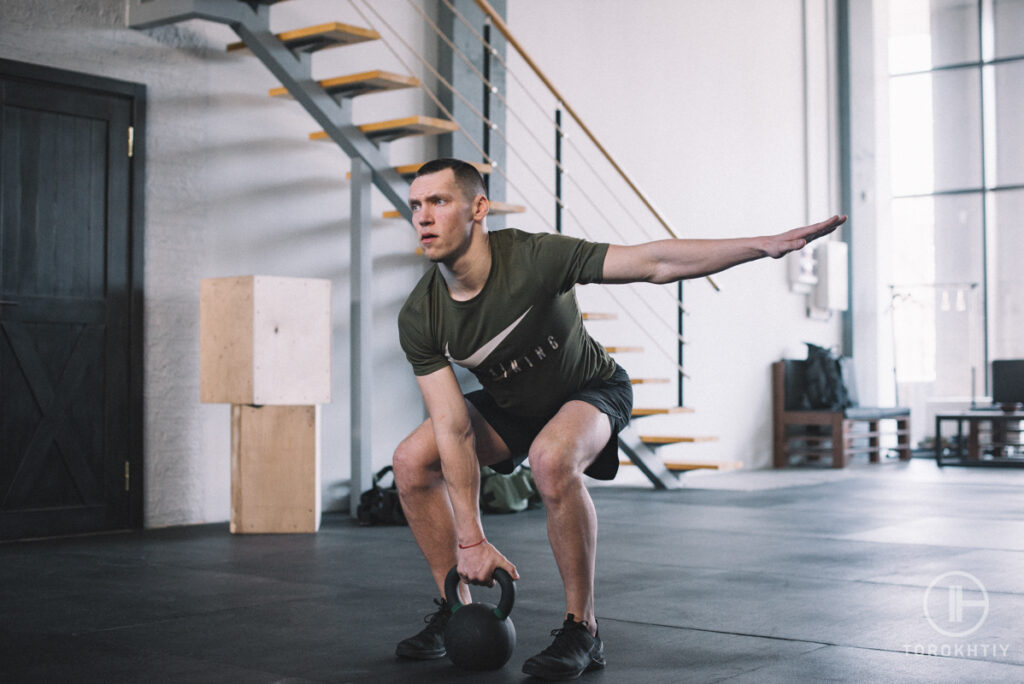
2. Intermediate
No leg workout with kettlebell should start without a warm-up, so do 5-10 minutes of jumping jacks, leg swings, and bodyweight squats.
Once you’re warmed up, start with goblet squats. You will do 4 sets of 10 to 12 reps, and unlike the beginner workout routine, this one needs a moderate-weight kettlebell; anywhere from 26 to 35 lbs. is fine. Make sure to maintain the correct form and rest for 30 seconds between sets.
4 sets of 15 to 20 reps of kettlebell swings are next, with a focus on powerful hip thrusts. Again, use a moderate-weight kettlebell. Don’t skip 30-second rest periods between sets.
You’ll then go on to Bulgarian split squats – 3 sets of 10 reps per leg. Hold a kettlebell in each hand, and then do split squats with one foot elevated behind you.
Calf raises are next, and for these, you’ll need a kettlebell weighing from 18 to 26 lbs. Do 3 sets of 15 to 20 reps and then finish with Romanian deadlifts.
With deadlifts, make sure to keep your back straight and hinge at the hips. Rest for 30 seconds between sets, and then cool down with 10 minutes of static stretches.
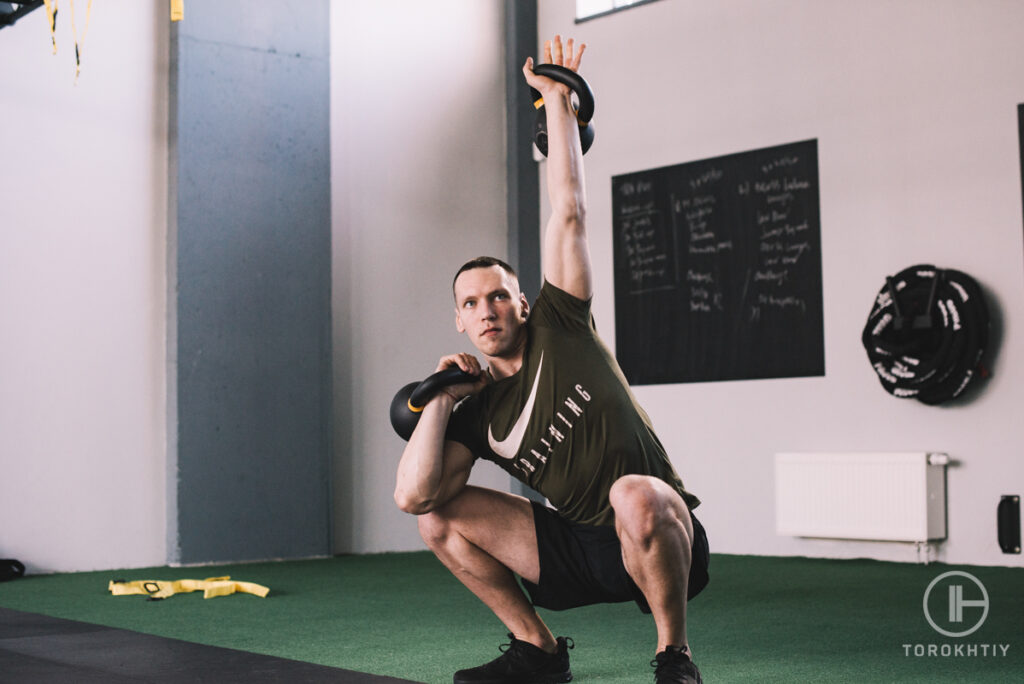
3. Advanced
The warm-up part is the same as for the previous two routines – 5 to 10 minutes of light cardio or dynamic stretching.
Then, the workout you’ll start with is goblet squats, and you’ll do sets of 12 to 15 reps. The weight of the kettlebell should be anywhere from 35 to 53 lbs. Focus on deep squats and controlled movements and rest for 30 seconds between sets.
Proceed to do 4 sets of 20-25 reps of kettlebell swings. The emphasis is on explosive hip thrusts. The kettlebell weight remains the same – 35 to 53 lbs.
Pistol squats are next, and you need 3 sets of 8 reps per leg. Use a lightweight kettlebell(s), or no kettlebell at all to ensure you can perform the movement correctly. As your body gets more comfortable and attuned to the movement, feel free to gradually increase the weight. Again, the main thing to focus on is control and correct movement.
For the next exercise, you’ll need a sturdy box or a platform, because you’ll be doing box jumps – 3 sets of 10 reps. Start off with doing the workout without a kettlebell. Once adjusted to the movement, try with a lightweight kettlebell but low box, then the goal is increasing the weight or box height over time. The jumps need to be explosive, and the landings need to be soft for this exercise to be fully effective, so focus on that. If you feel the weight of the kettlebell is holding you down too much or is preventing you from completing the workout successfully – decrease the weight.
The last exercise you’ll do is single-leg deadlifts, and you’ll need a 35-53 lbs. kettlebell for them. Rest for 30 seconds between sets and cool down with 10 minutes of static stretches.
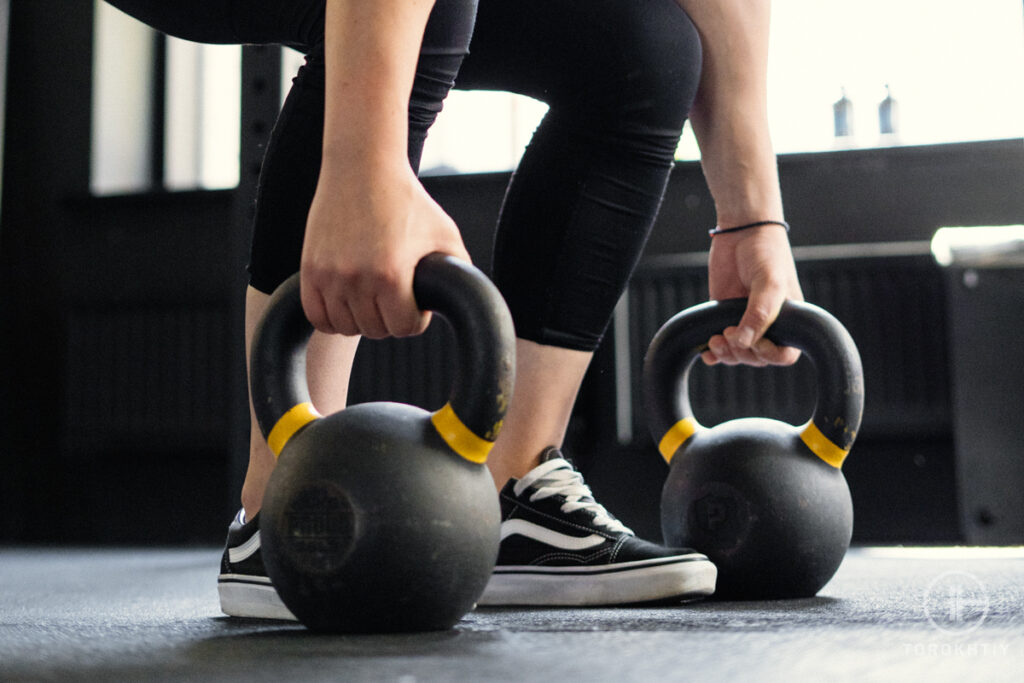
Safety Tips and Common Mistakes in Kettlebell Workouts
No matter what type of workouts you do, safety should always be your priority. Of course, it doesn’t mean you need to be afraid of mistakes because regardless of what you do, you’ll make them. But there are ways to recognize and prevent them, so you’ll make as little of them as possible.
The first thing to watch out for is the weight – most people think they need a kettlebell heavier than what’s suitable for them. This can lead to discomfort and injuries. Regardless of whether you are a beginner or expert, your number one priority during training should be form, not weight (or workout intensity). You need a light kettlebell (or even an adjustable one so you can vary the weight), and you first need to learn how to keep the form correct. If your form is off, your workout will be much less effective, and you can end up injuring yourself.
As your fitness level progresses, you can up the weight, plus you can also increase the number of sets and reps. Always make sure to keep your moves controlled and precise.
Each workout session needs to start with a warm-up, and you also should not skip the cool down. It’s only 15 to 20 additional minutes out of your day, and both are important to prevent strains and promote muscle recovery.
Lastly – remember to have fun. Don’t look at your workout routine as a chore because working out has a lot of health benefits, and if you keep at it, the results you’ll get will motivate you like nothing else. If you get bored, switch it up a bit – include different workouts into your routine or vary the weight of your kettlebell.
Kettlebells We Recommend
ROGUE KETTLEBELL – E COAT
- Weight range: 9-88 lbs.
- Increments: 9lb / 13lb / 18lb / 26lb / 35lb / 40lb / 44lb / 53lb / 62lb / 70lb / 80lb / 88lb
- Adjustable: No
- Handle diameter: 1.2″ (9lbs.-18lbs.), 1.4″ (26lbs.), 1.5” (35lbs.-88lbs.)
- Material: Cast Iron
- Coating: Black E-Coat, Semi-Gloss
- Color: Black
- Price per pound: ∼ $2.49
- Can be dropped? Yes
If you’re in the market for new kettlebells, don’t look any further than these! In collaboration with Cadillac Casting, Inc., Rogue made truly exceptional kettlebells. They’re made of cast iron, and their performance and durability are unmatched.
It’s not easy to find anything made in the US these days, but these kettlebells are one of those few pieces that were not made overseas. Their ductile iron construction is known for being extremely robust and resistant to corrosion.
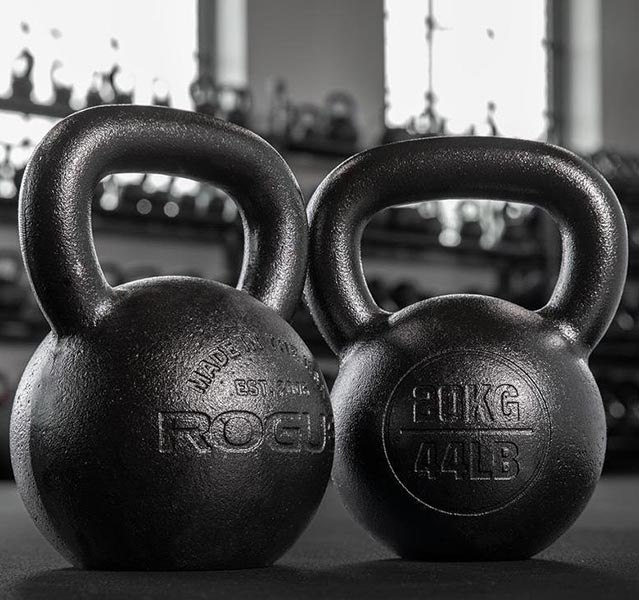
Now you may be thinking that such heavy-duty kettlebells are for advanced users only, but that’s not the case. They come in a wide range of different weights – from 9 lbs. to 88 lbs. so anyone can find a kettlebell for themselves. The 40 lbs. kettlebell even meets US Army specifications for the Combat Fitness Test, so that’s how high the quality of these kettlebells is.
If you use them with chalk, however, you may have some slight issues with grip, but overall, you won’t find kettlebells that are better than these.
Positives:
Could be better:
FAQ
Can you build legs with kettlebells?
Yes, you definitely can build very well-defined leg muscles with kettlebells! Leg workouts that include kettlebells are very good at targeting key leg muscles, like quadriceps, hamstrings, glutes, and calves. If you increase the weight of the kettlebell as your fitness level improves and if you vary your workouts, kettlebells can give you some fantastic results.
Are kettlebell swings a good leg workout?
This workout is good for both your legs and your core, which is why you’ll see it in a lot of fitness routines. Kettlebell swings engage many leg muscles, and also target your core, lower back, and shoulders, so it’s a highly effective workout for building strength and endurance.
Do kettlebell squats build quads?
Yes, they can be great at building your quads. Kettlebell squats heavily engage your quads because they work to extend your knees and lift the weight. Of course, you need to make sure you’re maintaining proper form for the squats to be able to target your quads.
Conclusion
To sum everything up – leg exercises with kettlebell are an excellent way to make your leg day more effective. They will build strength, tone your muscles, and improve your fitness in general. Your fitness level does not matter at all, because everyone can benefit from including a kettlebell in their exercises.
I’d love to hear what you have to say about this! What’s your favorite lower-body kettlebell workout? Do you look forward to leg day with kettlebells? What changes have you seen after you decided to include a kettlebell in your training routine? Do you have any tips to share?
Let’s start a discussion! Leave your tips and opinions in the comment section.
Also read:
- What Do Kettlebell Swings Work
- Kettlebell Core Exercises
- Beginner Kettlebell Workout
- Kettlebell Chest Workout
- Best Kettlebells
- Best Weightlifting Belt
- What Are Kettlebell Swings Good For
References:
1) Jason Brumitt MSPT, SCS, ATC, CSCS, Hui En Gilpin BS, SPT, Meredith Brunette BS, SPT, Erik P. Meira PT, SCS, CSCS, “INCORPORATING KETTLEBELLS INTO A LOWER EXTREMITY SPORTS REHABILITATION PROGRAM”; National Library of Medicine, https://www.ncbi.nlm.nih.gov/pmc/articles/PMC3096147/ (accessed 11 September, 2023).
2) Silvia Stagi , Gabriele Mulliri, Azzurra Doneddu, Giovanna Ghiani, Elisabetta Marini, “Body Composition and Strength Symmetry of Kettlebell Sport Athletes”; MDPI, https://www.mdpi.com/2079-7737/12/3/440 (accessed 11 September, 2023).
3) n/a, “Slowing bone loss with weight-bearing exercise”; Harvard Health Publishing, https://www.health.harvard.edu/staying-healthy/slowing-bone-loss-with-weight-bearing-exercise (accessed 11 September, 2023).
4) April Chang-Miller M.D., “Exercising with osteoporosis: Stay active the safe way”; Mayo Clinic, https://www.mayoclinic.org/diseases-conditions/osteoporosis/in-depth/osteoporosis/art-20044989 (accessed 11 September, 2023).
5) n/a, “American Council on Exercise (ACE) Study Reveals Kettlebells Provide Powerful Workout in Short Amount of Time”; Cision PR Newswire, https://www.prnewswire.com/news-releases/american-council-on-exercise-ace-study-reveals-kettlebells-provide-powerful-workout-in-short-amount-of-time-83876187.html (accessed 11 September, 2023).
6) Hyoung-Kil Park, Min-Kyung Jung, Eunkyung Park, Chang-Young Lee, Yong-Seok Jee, Denny Eun, Jun-Youl Cha, and Jaehyun Yoo, “The effect of warm-ups with stretching on the isokinetic moments of collegiate men”; National Library of Medicine, https://www.ncbi.nlm.nih.gov/pmc/articles/PMC5833972/ (accessed 11 September, 2023).
7) Stacey Carter, “Why it’s important to cool down after exercise, according to the science”; Live Science, https://www.livescience.com/why-its-important-to-cool-down-after-exercise-according-to-the-science (accessed 11 September, 2023).
8) n/a, “Army Combat Fitness Test”; U.S. Army, https://www.army.mil/acft/ (accessed 11 September, 2023).
Why Trust Us?
With over 20 years in Olympic Weightlifting, our team does its best to provide the audience with ultimate support and meet the needs and requirements of advanced athletes and professional lifters, as well as people who strive to open new opportunities and develop their physical capabilities with us.
By trusting the recommendations of our certified experts in coaching, nutrition, dietology, and sports training programming, as well as scientific consultants, and physiotherapists, we provide you with thorough, well-considered, and scientifically proven content. All the information given in the articles concerning workout programming, separate exercises, and athletic performance, in general, is based on verified data. We ensure that you can rely on our professionals’ pieces of advice and recommendations that can be treated as personalized ones which will benefit you and fully meet your needs.
The product testing process is described in more detail here
Author: Ihor Shymechko
Pro Olympic Weightlifter, Coach
Best Results: Snatch – 208 kg,
C&J – 240 kg
Ihor has been a professional weightlifter since 1996, boasting over two decades of competition experience. His notable achievements include clinching the European Championship in 2009 and securing a silver medal in the 105kg division at the Senior World Championships in 2011. Ihor represented his country in the 2008, 2012, and 2016 Summer Olympics. After retiring from competitive weightlifting, he transitioned to coaching, leveraging his vast experience to guide athletes who now compete on both national and international stages.

